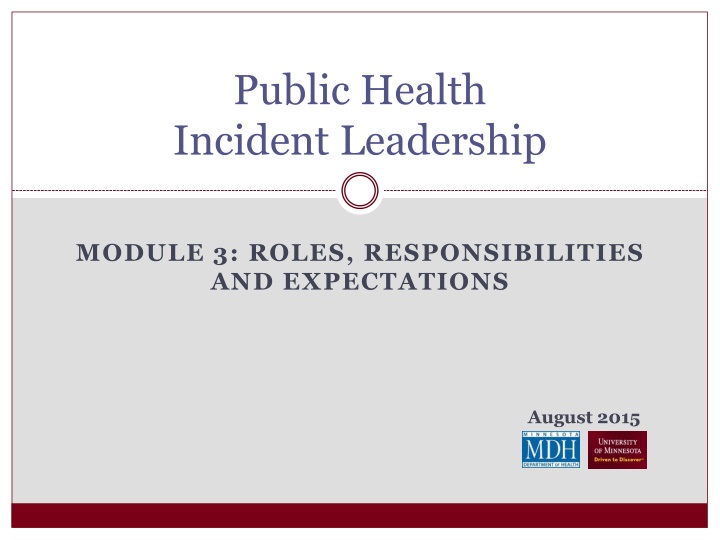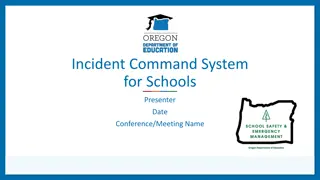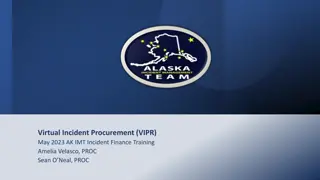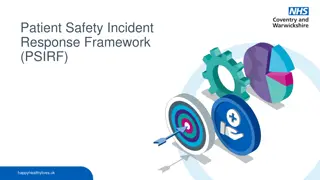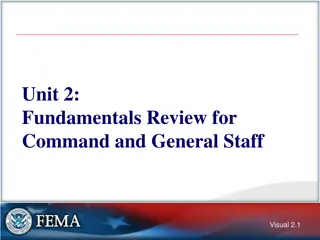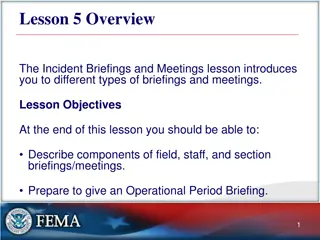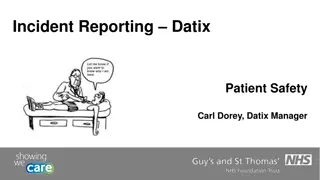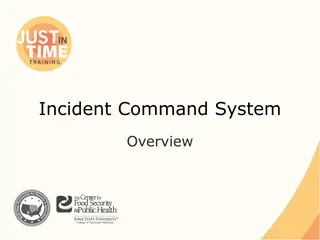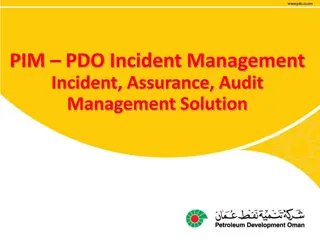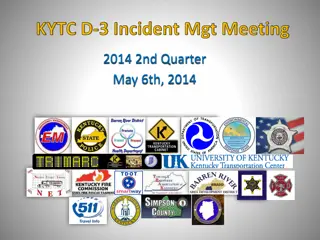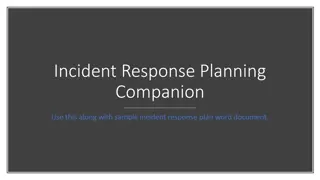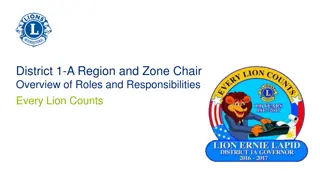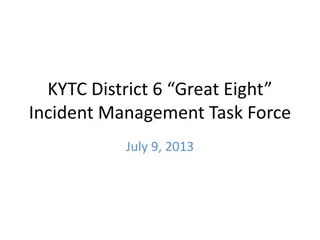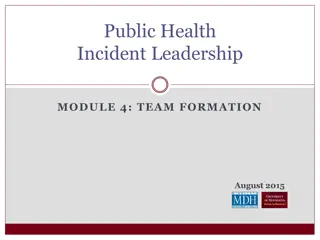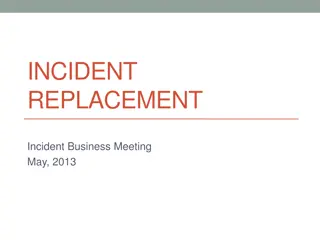Public Health Incident Leadership: Roles, Responsibilities, and Expectations
Explore the positions, responsibilities, and expectations within the Incident Command System in public health incidents. Learn about the Incident Commander's role, the need for timely decision-making, and the structure of the Incident Command System. Understand the importance of common processes and language for an effective and efficient response to incidents with public health implications.
Download Presentation

Please find below an Image/Link to download the presentation.
The content on the website is provided AS IS for your information and personal use only. It may not be sold, licensed, or shared on other websites without obtaining consent from the author.If you encounter any issues during the download, it is possible that the publisher has removed the file from their server.
You are allowed to download the files provided on this website for personal or commercial use, subject to the condition that they are used lawfully. All files are the property of their respective owners.
The content on the website is provided AS IS for your information and personal use only. It may not be sold, licensed, or shared on other websites without obtaining consent from the author.
E N D
Presentation Transcript
Public Health Incident Leadership MODULE 3: ROLES, RESPONSIBILITIES AND EXPECTATIONS August 2015
Objectives Review Incident Command System positions and responsibilities Identify responsibilities of Incident Commander Increase understanding of the expectations of the Incident Management Team
ICS in Public Health Not business as usual Challenging model Decisions based on incomplete information Need for timely decision making
Why ICS? Effective and efficient response to incidents with public health implications Establishes common processes for planning and management of resources Provides a common operating structure Respond with partners in a seamless, coordinated fashion Provides common language when working with partners
Incident Commander Know agency policy and lines of authority Responsible for all ICS management functions until delegated Ensure incident safety Overall responsibility for managing the incident by establishing objectives, planning strategies, and implementing tactics Establish immediate priorities Determine incident objectives and strategies Establish type of organization needed and monitor functioning and effectiveness of organization in managing the incident Approve the Incident Action Plan (IAP)
Incident Commander Manage Planning Meetings as required Coordinate activity of Command and General Staff Approve requests for additional resources or for the release of resources Authorizes release of information to the news media Orders demobilization of the incident when appropriate Ensure incident after-action reports are complete Display command presence
Deputy Incident Commander A Deputy Incident Commander may be designated to: Perform specific tasks as requested by the Incident Commander Perform the incident command function in a relief capacity Represent an assisting agency that shares jurisdiction
Roles and Expectations Implementing effective ICS teams is more than knowing the roles Effective teams both understand and manage expectations Command and general staff are aware of what is expected of them by the Incident Commander Incident Commander is aware of what is expected of him or her by the incident management team
Group Activity For your assigned ICS position: 1. List 3-4 key responsibilities 2.List what support you as Incident Commander expect from this position 5 Minutes
Public Information Officer (PIO) Advises the Incident Commander on information dissemination and media relations IC approves media releases Monitors and forwards media information that may be useful to incident planning Develops information for use in media briefings Conducts periodic media briefings Arranges for tours and other interviews or briefings that may be required Maintains current information summaries and/or displays on the incident Makes information about the incident available to incident personnel Participates in the Planning Meeting
Expectations: Public Information Officer Incident Commander Expectations of Public Information Officer Keep personnel up-to-date on major current affairs Coordinate with Liaison Officer in relations with stakeholders Identify and keep IC informed of emerging issues Coordinate and represent the IC in off-site PIO activities Promote a positive impression of all information Public Information Officer Expectations of Incident Commander Approve press releases in a timely manner Cooperate with media requests and public information meetings Provide direction on his/her media expectations
Safety Officer Advises the Incident Commander on issues regarding incident safety Identifies and mitigates hazardous situations Ensures safety of all incident personnel Works with Operations to ensure safety of field personnel Has authority to stop unsafe acts outside the scope of the IAP Develops safety procedures and safety plan Reviews IAP for safety implications and documents on 215A Reviews and approves Medical Plan Initiates preliminary investigation of accidents within incident Participates in Planning Meetings Ensures safety messages and briefing are completed
Expectations: Safety Officer Incident Commander Expectations of Safety Officer Identify, manage, instruct and mitigate all hazards on the incident Keep IC informed on trends/causes of accidents and illnesses Promote attitude of 100% compliance with safety rules Provide relevant and effective safety message in each IAP Safety Officer Expectations of Incident Commander Emphasize safety in all communications and actions Support recommendations for changes in tactics for safety reasons
Liaison Officer Assists the Incident Commander by serving as a point of contact for representatives from other response organizations and entities Maintains list of assisting and cooperating agencies and agency representatives Assists in setting up and coordinating interagency contacts Provides briefings to and answers questions from supporting organizations Monitors incident operations to identify current or potential inter-organizational problems Participates in Planning Meetings Provides current resource status, including capabilities and limitations of partner agency resources Provides partner agency specific demobilization information and requirements
Expectations: Liaison Officer Incident Commander Expectations of Liaison Officer Address stakeholder concerns and issues in a positive manner Identify and coordinate with all involved agencies and organizations Provide a positive impression of incident to other agencies/stakeholders Coordinate with Public Information Officer in relations with stakeholders Keep other IMT members aware of issues with assisting agencies Liaison Officer Expectations of Incident Commander Advise and counsel on issues presented by assisting agencies Provide overall mission and direction Show willingness to engage with stakeholders when necessary
Operations Section Chief Manages tactical operations Responsible for the operations portion of the Incident Action Plan (IAP) Supervises the execution of the incident s operations Requests additional resources to support tactical operations Maintains close contact with subordinate positions Makes or approves changes to operations portion of the IAP Approves release of resources from assignments to the incident Maintains close contact with the Incident Commander
Expectations: Operations Section Chief Incident Commander Expectations of Operations Chief Recommend strategies to reach objectives Keep IMT informed of planned tactics to ensure timely input and support Order resources within fiscal and environmental boundaries Report unusual events and activities; provide daily updates Insist all known safety procedures are followed Maintain effective communication with all cooperating agencies Operations Chief Expectations of Incident Commander Supply objectives Point out any constraints on strategies or tactics. (environmental, political or financial)
Planning Section Chief Collects and manages all incident-relevant operational data Prepares the Incident Action Plan (IAP) Provides input to the Incident Commander and Operations Chief Conducts and facilitates Planning Meetings Establishes information requirements and reporting schedules Reassigns existing personnel to ICS organizational positions as appropriate Develops plans for demobilization
Expectations: Planning Section Chief Incident Commander Expectations of Planning Chief Exercise effective leadership and organization of all incident meetings and briefings. Ensure established planning process is followed, timely and accurate. Maintain overview of all incident activities Planning Chief Expectations of Incident Commander Provide incident objectives Provide Planning Meeting schedules/operational periods Provide deadlines for Incident Action Plan Review and approve Incident Action Plan
Logistics Section Chief Manages all incident logistics Orders, obtains, maintains and accounts for essential personnel, equipment and supplies Provides logistics input to the Incident Action Plan Identifies anticipated and known incident service and support requirements Requests additional resources as needed Develops the communications, medical and traffic plans as needed Oversees demobilization of the Logistics Section
Expectations: Logistics Section Chief Incident Commander Expectations of Logistics Chief Managing the ordering process to meet all incident needs Anticipate and maintain supplies ahead of the need whenever possible Work closely with Operations to provide logistical support and coordination Coordinate with the supporting EOC to ensure effective relations Logistics Chief Expectations of Incident Commander Provide priorities for ordering personnel, supplies and equipment Provide support for logistics activities Keep in the loop for planned direction of the incident
Finance/Administration Section Chief Manages all financial aspects of an incident Provides financial and cost analysis information as requested Ensures compensation and claims functions relative to the incident are being addressed Develops an operating plan for the Finance/Administration Section Fills section supply and support needs Ensures all personnel time records are accurately completed Ensures all obligation documents are properly prepared and completed
Expectations: Finance Section Chief Incident Commander Expectations of Finance Chief Advise all command and general staff about fiscal, contract and other administrative matters Provide cost analysis if requested Possess good knowledge and ability to operate Finance Section effectively Coordinate with all staff and responsible agencies to meet administrative requirements Finance Chief Expectations of Incident Commander Provide general advice and counsel Provide financial and political constraints Provide feedback on performance and evaluation Approval of excess staff time
Exercise: Delegation of Tasks You are asked for a map of the incident area. Who would you go to?
Exercise: Delegation of Tasks You received the following notice: The National Weather Service has just announced that the Winter Storm Warning for the Metro and South Central Minnesota is being changed to a Blizzard Warning. What do you do with this information?
Exercise: Delegation of Tasks A mass vaccination site calls to tell you that they are running out of vaccine. Who would you go to ?
Exercise: Delegation of Tasks You received a call that one of the trucks dispatched to collect personal protective equipment (PPE) from a large business supplier has broken down after picking up the PPE supplies. Who would you go to?
Exercise: Delegation of Tasks The receptionist tells you that she can t keep up with the phone calls coming in about an infectious disease. Who would you go to?
Exercise: Delegation of Tasks Re-elections are right around the corner. An elected official wants to attend the health department planning meetings. Who would you go to?
Exercise: Delegation of Tasks A long-term care facility has lost main power due to a storm. The facility has limited back- up generator capacity. They have 60 residents and do not want to evacuate in these conditions. Who would you go to?
Exercise: Delegation of Tasks Media are requesting messages on the health dangers of the smoke from the forest fires to those with respiratory problems. Who would you go to?
Exercise: Delegation of Tasks Your office is experiencing intermittent power and phone outages. Who would you go to?
Framework for Public Health Incident Leadership Skills Behaviors Do Performance Skills Leadership Knowledge Cognitions Think Situation Monitoring Communication Attitudes Affect Feel Mutual Support Attitudes Knowledge
